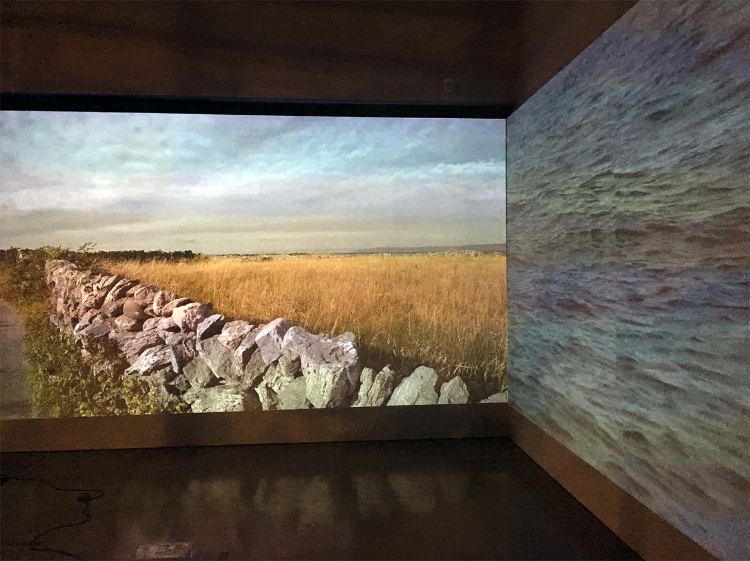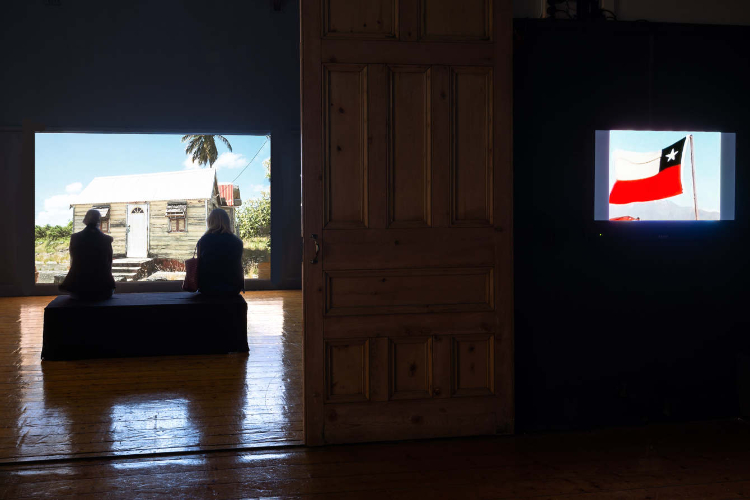Review | The Ocean Between @ Crawford Art Gallery
In The Ocean Between, Irish artist Marianne Keating looks at the emigration of Irish people to Barbados and Jamaica as indentured labourers in the 17th and 19th centuries and the impact these Irish immigrants had on these two countries. In the pre-African slave era, Irish people were recruited to work on the sugar cane plantations of Barbados.
Plantation owners would cover the cost of their travel, housing, medical needs and children’s schooling and, in return, the Irish labourer would be required to work for free for a number of years, after which time they were free to do as they pleased. The descendants of those early immigrants now form one of the poorest and most marginalised groups of white people in the country. Today, around 25% of Jamaica’s population are descended from these indentured Irish labourers.
Landlessness
The exhibition consists of a series of seven films shown in darkened exhibition rooms and a series of three large-format photos of Caribbean coastline in the outer corridor. Landlessness (2017) is the oldest of the films in the exhibition and forms the cornerstone of Keating’s exploration of the topic. In the two-channel film, which is displayed on two large screens, we are presented with footage of landscapes but also text, taken from historical archives and Limerick newspapers of the day.

The film opens with footage of the sea and Irish shoreline on one screen and with a walk up an Irish hill on the other, complete with verdant grass, wild flowers and rocks. The text of a conversation between a French Sociologist and the Secretary of the Irish Poor Law Commission from 1835 is displayed on screen, intermittently breaking up the landscape shots. The men discuss the levels of poverty seen throughout the country at the time.
It then transitions into a second section which features a discussion between the Land and Emigration Commissioner for Great Britain and Ireland and the founder of the West India Immigration Society. The images begin once more with both screens showing the scene of the sea and Irish shoreline, but the second screen soon moves into scenes of the lush jungle/rainforest of Jamaica.
We move to a conversation between the Governor in Chief of Jamaica and the Agent-General of Immigrants at the time about some of the issues encountered with the immigrants. The immigration agent tells of issues where the immigrant villages weren’t ready for people when they arrived and many got sick in the low-lying Kingston area, while others grew discontent and some had to be sent back to Ireland at great expense.
In other cases people left their work altogether, still owing a great debt to the plantation owners. Most of these inevitably made their way to the capital, Kingston, where they were destitute. As we learn this, we are shown images of vast cane fields with small dirt roads running through them. They seem oppressively tall and claustrophobic and the disparity with the open fields of Ireland is very apparent.
The contrasting landscapes of both countries shown throughout this film are extremely effective in personalising this emigration event. One can palpably feel the weight of this move and the consequences of it for those thousands of people who left Ireland. Along with the complete culture shock that must have awaited thee people, in terms of weather, language, food, and the type of work, must have been the realisation that most of them would never see their homes and the country they had been born in again.
Land-Path Migration
In Land-Path Migration (2019), the artist explores the idea of land and its ownership in a film that features a constant voiceover. We begin on the shoreline of Barbados before moving across the lush landscape. Keating suggests that land can be an archive of the past, one you can try to construct a narrative from but that it cannot tell the full story on its own.
Land is always second hand, she states, and is handed down. She notes the connection between Ireland, Barbados and Jamaica not just as islands but as island nations that were colonised by the British. This film is a high-level view of the nature of land and the marks left behind by people, which is further explored in Below Cliff (2019).
Below Cliff
In this film, Keating attempts to find the village of Broken Cliff, an 18th century poor white community in the east of the country that was made up of descendants of poor indentured labourers from Ireland, England, Scotland, and Wales. We follow Keating in first-person view as she walks deep into a wood to find the remains of the village.
Though only abandoned in the 1950s, the village is hard to locate as the custom at the time was to build chattel houses that could be easily dissembled and moved. All that remains of the community are the low stone foundation walls and discarded bottles outside of what would have been the run shop. We hear Keating talk to Mr. Norris, an elderly man who used to live in the village until he was fourteen when his family left, taking their house with them.
They don’t do much in the cane-hole way
We continue honing in to the more personal experience in They don’t do much in the cane-hole way (2019). Here, the artist, who is off-camera, meets a retired female teacher in Barbados who is a descendant of Irish indentured labourers. The woman shows Keating some of the exotic fruit trees that grow behind her house, including lemons, bananas and bread fruit.
I am sure that there is a touch of an Irish accent in her Caribbean lilt but realise that may be imagined on my part. It strikes me that this could be any older Irish woman showing you the fruits of her labour. She is friendly and well up for giving a ribbing to the younger relations who come to help her. The film cuts to a scene of torrential rain against the backdrop of a tropical forest and banana trees as if to reiterate that, though the landscape is so very different, we as people are not.
Better Must Come
In Better Must Come (2019), Keating uses archive footage to analysis the political and social situation in Jamaica. The film is constructed from a mix of discussion pieces, schoolchildren rapping on the street, sugar cane harvesting and processing, and violent shootouts. It looks at those vying for power when the country gained its independence from the UK in the 1960s, including key figures of Irish descent who were instrumental at the time. Make the Economy Scream (2018) explores the American attempt to destabilise the Jamaican government, which was led by a man of Irish descent, in the 1970s.
Keating’s exhibition explores this little known history of the Irish people who emigrated to the Caribbean in a way that gives new perspective, not only on this particular migration, but on modern day migration. It makes us question the narratives around migration and the power balance between those of us from the Western world versus the poorer global south. She invites us to consider the impact that the Irish diaspora and their descendants had on Jamaica and Barbados.

For me though, the power of these works in in the personal narratives. The artist’s astute use of landscape footage of both countries and the archival sources of the time in Landlessness really illustrates the dire situation of the Irish people at the time, the enormity of their decision to leave for a better life and the hardship they must have endured.
In seeking out the places where these people live and meeting descendants of those indentured labourers, she reminds us that we are talking about real lives, families and communities who were and are just like us, despite the four-thousand or so miles in between. One cannot help but compare the situation of the Irish diaspora with those of today’s global migrants.
The Ocean Between is an engrossing set of films that draw you in and bring you on a journey. Never sanctimonious, they explore this section of our diaspora in a way that personalises the historical events around it and invite a questioning of broader perspectives around modern-day issues of migration and nationality. This is an exhibition that is well worth spending an hour of your time with.
The Ocean Between is on show at the Crawford Art Gallery, Cork until the 22 September 2019.
